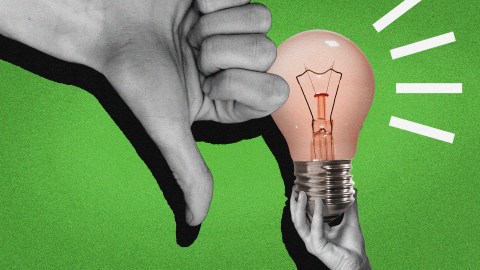Why we reject new ideas

When the personal computer was first introduced to the public in the 1980s, some people developed what came to be known as “computerphobia,” a reluctance to talk or even read about computers, a fear of being replaced by the machine or enslaved by it, a conviction that the computer would damage one’s health, and a range of other anxieties.
The phenomenon was described in psychology studies, magazines and newspapers, even computer training manuals. Personal computer enthusiasts, of which there were many, thought the resisters were crazy, but resisters thought the enthusiasts were suckers. Computerphobia peaked in 1986, and then slowly began to fade as people started using them. Turns out the personal computer is really great for learning new things, creative work, playing games, and connecting with loved ones, peers, and distant places.
It’s no secret that transformative new ideas often face widespread rejection when they first come to light. The histories of science and culture are littered with examples. Recently, University of Utah business scholar Wayne Johnson and Cornell University creativity researcher Devon Proudfoot set out to try to answer why.
We wonder, is this brilliant or is this stupid?
“For a long time, creativity research has focused on how do you generate new ideas? What’s the secret sauce? I think that that’s not really the problem,” says Johnson. “There are so many ideas. It’s the acceptance of those ideas, getting people to support them, that is the hurdle.” In a series of five experiments, the scholars tested business venture pitches from the television show Shark Tank, films premiering at Sundance Film Festival from 2015 to 2022, abstract art, unusual sandwiches, and individuals’ intent to invest in novel ideas.
Their study, published in Nature, found that the more novel an idea is, the more groups of people disagree about its potential value—and that others interpret this disagreement as a signal of risk. Disagreement itself then generates resistance.
We caught up with Johnson to talk about what handicaps novel ideas.
You write in the paper that creative ideas are typically defined as ones that are not just novel, but also useful. How do we determine how useful a novel idea might be?
That’s one of the questions that the creativity literature has still not grappled with. It is difficult to define value, because what is valuable to one person may not be valuable to others. So both novelty and value are judged subjectively. Novelty itself is a hard thing to define. What is new? We have struggled and puzzled over that question for decades. The best answer that people have been able to come up with, in my opinion, is that novelty is distance from a reference point. So, take a traditional Pakistani dish. It’s not new at all, but if you introduce it to somebody in central Michigan who’s never heard of it, it’s quite new, right?
You also say there’s an inverse relationship between novelty and the extent to which you can predict its usefulness. Why is that?
Well, when we’ve been using a thing for a while, we have a pretty clear sense of what to do with it. So, for example, electricity. I know so many ways that’s useful. I use it every day. I have a really good handle on how useful electricity is. But when it was really new, people didn’t have any experience with it. They didn’t power their houses or their streetlights with it. And so there was the question of, will I even use this? Is this safe? For us now, those questions have all been answered and we have a whole lot more data and on how useful it is. So that’s what happens when an idea is new. We wonder, is this brilliant or is this stupid?
You had a significant personal experience with resistance to novel ideas. Could you tell me about that?
I was a military officer and one of my first contributions to the military was an innovation related to bomb-identifications in Afghanistan. It had such an incredible success rate that the military wanted me to teach it to others. But there was a lot of resistance because it required people to walk the roads and find bombs by hand, rather than stay in their vehicles. I would say, “Okay, I’m here to teach you.” And people would scoff or they would say, “No, we’re not going to do that.” They just didn’t buy it.
Do experts have a harder time with new ideas?
There’s a paper by Erik Dane from 2017 on something called cognitive entrenchment, which argues that the more expertise you have, the more kind of ossified your knowledge structures become, the less you expose yourself to other sources of information. And so it becomes really difficult to accept or value a new thing. We rely on experts to judge things, but novelty specifically by itself means that the expertise is less helpful. When something is new, nobody can be an expert on it. That’s why sometimes experts make such mistakes.
A biologist named Andres Wagner recently wrote a book called Sleeping Beauties. Part of his premise is that innovations in biology and culture have to be introduced multiple times before they catch on. What do you think about this?
It fits very well with our theory. When an idea is really, really new, nobody has a reference point for that idea. Every subsequent introduction is a possibility to establish a positive reference point of comparison.
Can you give me an example of how a reference point might influence one’s perception of value?
In the ’70s, Tom Gilrovich did a study where he created a false country. And he asked his study subjects, should the United States get involved in this country? But first he gave them a frame of reference. One group read about the U.S. involvement in Vietnam, another group about the U.S. involvement in Germany in World War II. The people who read about U.S. involvement in Germany were more supportive in this new case. People who were using Vietnam as their reference point, they came to a different conclusion about whether intervention was a good idea.
What do your findings tell us about how we can ensure that valuable innovations are not lost?
What we see here is that people are drawing conclusions about an idea based on whether other people agree or disagree about it. Disagreement makes people think the idea is risky. But I think the disagreement really tells us something about the evaluators: They’re using different criteria, they may lack the expertise for it. So the biggest thing that I would say is don’t give up when you see a lot of disagreement about an idea. Don’t just say, “Ooh, controversial, bad, we’re done.” So if you’re trying to see if ideas are good or not, come up with a really good evaluation checklist or criteria and have everyone use that.
If you are the one who has the creative idea and you want it to catch on, what do you do?
Well, if you’re savvy, what you want to do is to create a good positive reference point. So when people come up with a new thing, what do they say? This is the Uber of cat food, or whatever. Uber worked really well, it made a lot of money. If you use Uber as your reference point, it’s like, “Oh, here’s a new peer-to-peer opportunity. This is something that can really take off.”
This article originally appeared on Nautilus, a science and culture magazine for curious readers. Sign up for the Nautilus newsletter.





